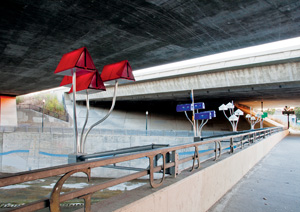ROBIN LASSER and I are strolling beneath San Fernando Street and the Highway 87 overpass—an ominous trilevel milieu of concrete and steel enveloping what’s left of the Guadalupe River.
As we navigate the jogging path just west of the Adobe building, directly above us sits her art installation, titled Floating World: A Tent City Campground for Displaced Human and Bird Song.
Fashioned after FEMA relief shelters, five clusters of fabricated tents are cantilevered off the San Fernando hand railings. Sound collages emanate from the tents, all of which address issues relating to the river’s health and history—floods, wildlife, garbage, the homeless population and more.
We hear the sound of an airplane overhead plus a few cars and pedestrians on San Fernando. Barely any water sits in the riverbed. The processed sounds from the installation echo underneath the bridge. It is twilight, with the tent clusters forming the only smidgens of color amid the monotonous gray surroundings.
“You’ve got three stories of concrete, and this river,” Lasser observes. “It’s like a cathedral. It’s magical.” I agree, envisioning her voice as the birdsong and myself as the displaced human.
Conceived with artist Marguerite Perret, Floating World is one of six installations that make up “Art on San Fernando: Re-visioning the Corridor,” a series of projects along San Fernando from Diridon Station to Market Street. Each work addresses the relationship between the built environment and the natural world.
Lasser is currently an art professor at SJSU, and Floating World was commissioned by the city of San Jose’s Public Art program in collaboration with the 01SJ Art Biennial, which will soon explode all over downtown San Jose. Others who collaborated on the project were Bruce Scherting, James Stone, Anthony Teixeira, Keay Edwards and Sasha Vermel.
Each cluster of tents in Floating World symbolizes a different aspect of the river or its environs. For example, the tan-colored dome-looking tents emit sound compositions using recordings of local birds as the source material. A live microphone underneath the bridge picks up ambient noises and these sounds are routed through MAX/MSP software to modulate the composition of the bird sounds in real time. When a airplane flies overhead or a VTA bus thunders by, those disturbances cause the collage of bird sounds to become louder and higher in pitch. So the live sonic track from that tent cluster constantly changes according to the local sonic environment.
“This is reflective of how birds all over the world are changing their songs in order to be heard above anthropogenic human-made noise,” Lasser explains. “They do it as a survival tactic. They need to be heard by their mates. So they sing higher and louder as a result.”
The green-colored encampments emit sung voices, interviews and narration about climate change and natural disasters. The silver, octagonal tents broadcast interviews about the health and history of the river. The blue tunnel-shaped tents feature recordings of underwater sounds from the river, using weather data to further modulate the sounds, while the red tents broadcast a soundtrack about how human bodies relate to the land.
Even better, a beautifully creepy voyeuristic element emerges from the entire work. The homeless folk underneath the bridge sit and experience the sounds, wondering what’s actually going on. Pedestrians on the sidewalk stop and listen in, as if they’re eavesdropping on someone’s house.
Of course, with any work of public art, passers-by are encouraged to interpret the work however they see fit. Lasser says she actually enjoys watching bewildered bystanders approach the installation. It provides a social sculpture where people can meet and talk.
“There are the homeless that live in that space, as well as the locals who have their houses around there, as well as the businessmen crossing the street,” Lasser tells me. “So to be able to provide a kind of meeting ground, a place to explore all these things, even if it’s just subliminally, to me, as an artist, it’s the most incredible gift I can receive.”
01SJ Biennial
Downtown San Jose
Sept. 16–19




